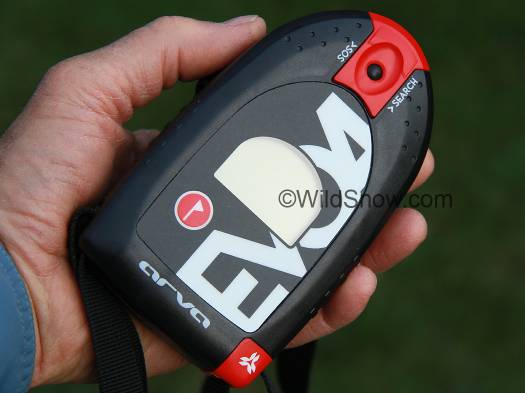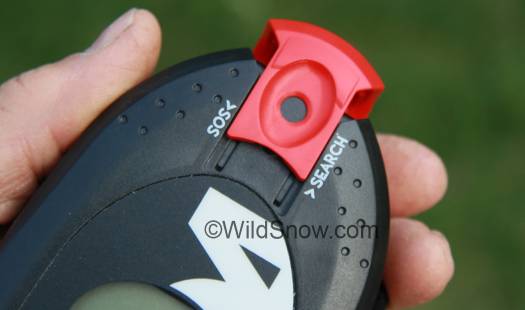I’ve had the Evo4 sample kicking around here since last spring (Arva spelling is probably Evo 4 with the space, but we’ll use the contraction Evo4 for easier writing). Too much backcountry skiing, too much traveling (oh the pain!), too much office remodeling, so little time. I did mess around with the Evo on-snow last spring, finished up evaluating this past few days. Word is this is the only “new” beacon model for 2015-2016. I guess that gets us off the hook for dozens of beacon reviews, and we can concentrate on the backcountry skiing binding wars?
This is an upgrade of the Arva Evolution 3+, a viable choice in its own right (and available now on sale). First thing I noticed about Evo4 is its hefty size. It covers an 8 x 13.5 centimeter footprint, thickness is 2.8 centimeters. Compare to a major competitor that’s noticeably smaller at 7 x 11.5 cm and about 2.3 cm thick, and thus easy to pocket. Weight at 9 oz, 255 grams (without harness) is 2 more ounces than competitor at 7 ounces.
First, range. My suspicion is with a case this big Arva has room for an exceptionally tuned and sensitive triple antenna array. Arva says the “search bandwidth” is 40 meters (131 feet). I did not get a test signal out that far, but did pick up at 33.5 meters (110 feet) from a transmitting beacon that showed 60% battery–totally adequate and downright excellent for the price. Pinpointing was ok in my tests, not exceptional yet sufficient to get your probing started in the correct spot.
Evo4 is as user friendly as any other ski touring avalanche safety beacon, and perhaps more than some. Search-transmit mode switch is a red slider on the curved tip of the case, easy to slap down into transmit mode if you’re doing a rescue and notice a large noisy cloud of white heading your way. You turn it on by connecting a red plastic strap anchor that triggers a magnetic switch. The harness straps can be removed and the anchor attached with a DIY lanyard. But truthfully, this beacon is so bulky you probably don’t want to be carrying it in a pants pocket. Instead, the included strap system is intuitive: One around the torso, one over the neck and under your arm. A wide portion of webbing looks comfy for your neck, but does little more than add bulk under your collar. Indeed, Evo4 weighs a few ounces more, but it’s still light enough to only need minimalist rigging.
Arva tells me they’ll have a different harness available this fall as an add-on purchase, one that allows more range of motion while doing pinpoint grid search. Good, as the harness I tested allows reaching out with the beacon by stretching the elastic torso strap, awkward and not ideal — especially if you’re layered up during a cold day of backcountry skiing. Worse, if you’re involved in a backcountry rescue and need the Evo out of harness, unclipping it turns it off. Perhaps that should be my main gripe with these sorts of harness integrated switches. They seem slick at first, but think it through.
Of course everyone wants to know about multiple burial modes, since running around digging up a group of buried avalanche victims is so easy and common. Right? I jest, but multiple mode is standard now in all full-function beacons so it might as well work. Arva’s setup is simple. You get close to one victim and press the red button with a flag icon. The closer transceiver gets 100% masked out and you’re on your way to searching for the next nearest. Some icons and that sort of thing also help.
If you study avalanche accidents, you might notice a common challenge to companion rescue is multiple individuals moving around the burial site with transmitting beacons, confusing all but the most practiced operators. Perhaps these unfortunate individuals are stunned, in shock or hysterical. In my view, this is where multiple masking functions could be much more important than in the rare multiple burial. Friend #1 is sitting in the snow moaning, and becomes combative when you try to unzip his coat and turn his beacon off. Instead, just mask him and keep going. Benefit: if another avy comes down his beacon is still transmitting.
Other details:
The device emits a beeping sound that varies with distance in search mode. Volume is low, with no option for setting. This is illustrative of a problem in designing human interfaces. If you provide sensory information it’s got to be totally perceptible in any situation, or you need to provide user control. Example: imagine a smart phone without a screen brightness or volume control. To all beacon makers, If you provide sound give us volume control.
EVO 4 has a slight curve to conform to your body and appears quite robust. A protective case is not supplied; one assumes it is unnecessary. The device runs on 4 AAA batteries, claiming 250+ hours battery life on transmit. That’s somewhat average and matches that of a competitor that uses only 3 batteries. Surprising, but perhaps Arva is being conservative in their metrics. Display is a grayscale passive LCD, our favorite for use in bright daylight. Illumination turns on automatically in search mode and is plenty bright for night work. Price is quite good for a beacon with the Evo features. (Said to be available sometime fall, MSRP under $300.)
Summary: Bulky beacon with excellent range and well designed interface. Competitive pricing. Viable option if you don’t mind carrying your transceiver with a torso harness. I enjoyed reviewing as this beacon seemed less complex and more user friendly than some of the other transceivers we’ve dealt with over the years.

Back of Arva Evo 4: You can see the four AAA batteries behind the cover. They’re easy to remove and replace, with obvious polarity indicators you don’t need a magnifying glass and headlamp to decipher.
(Note, I generally do NOT test beacons paired with similar models-brands. Real ski touring life involves random beacons, so my testing reflects that. Results vary with battery life, brand, and even how you hold the beacon and walk around. Thus, please know that any beacon testing and review (including Arva Evo 4) we do is not “scientific.”)
WildSnow.com publisher emeritus and founder Lou (Louis Dawson) has a 50+ years career in climbing, backcountry skiing and ski mountaineering. He was the first person in history to ski down all 54 Colorado 14,000-foot peaks, has authored numerous books about about backcountry skiing, and has skied from the summit of Denali in Alaska, North America’s highest mountain.




